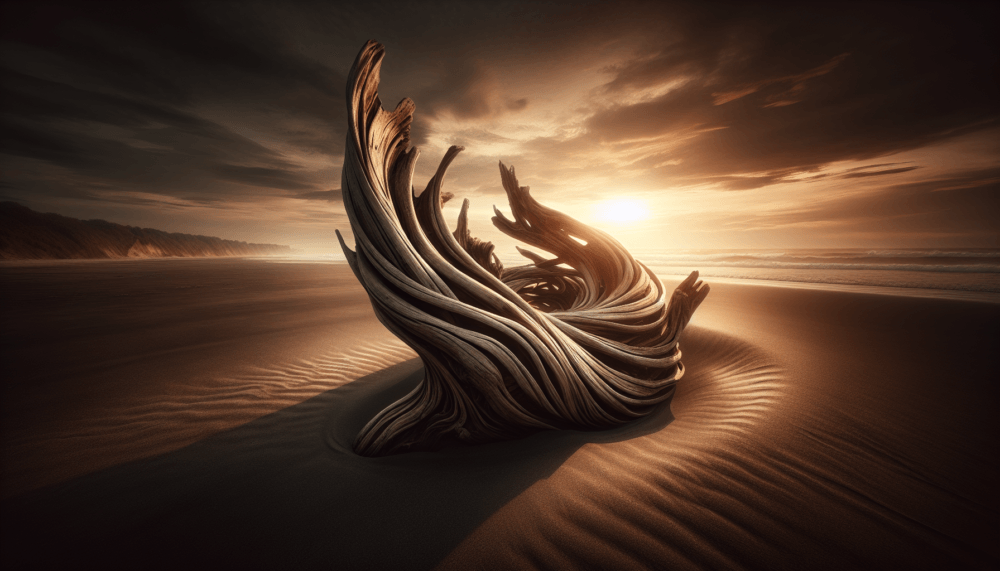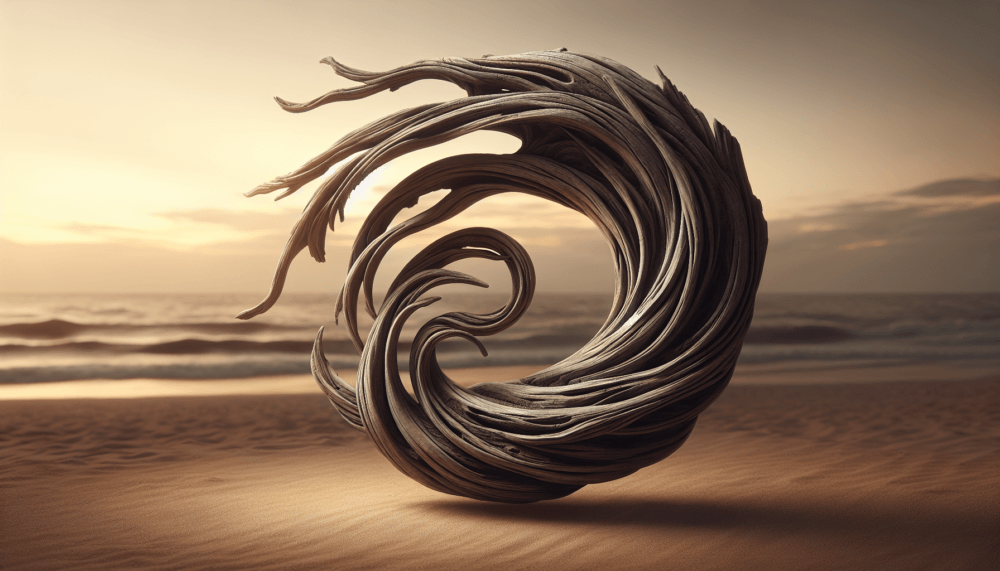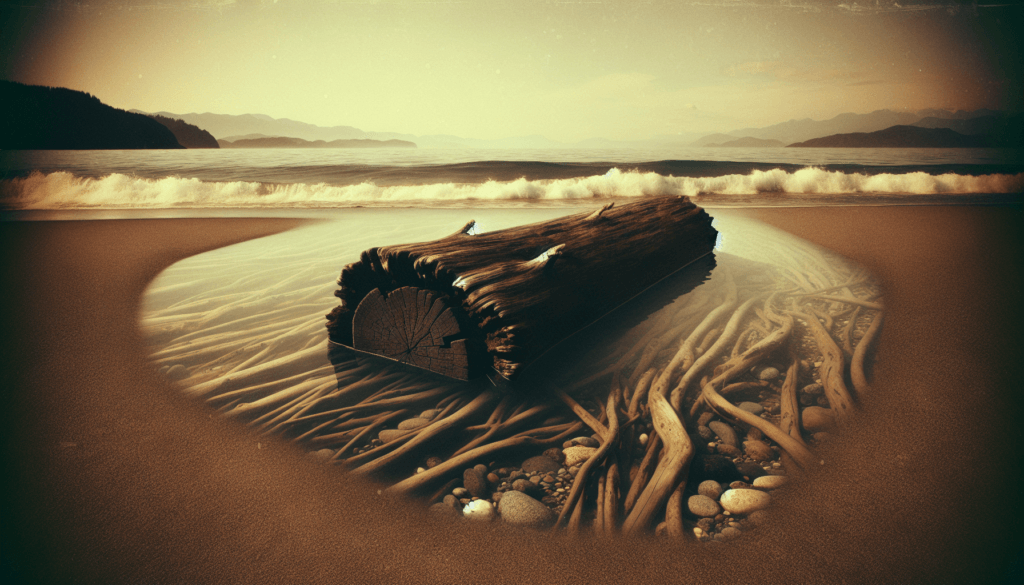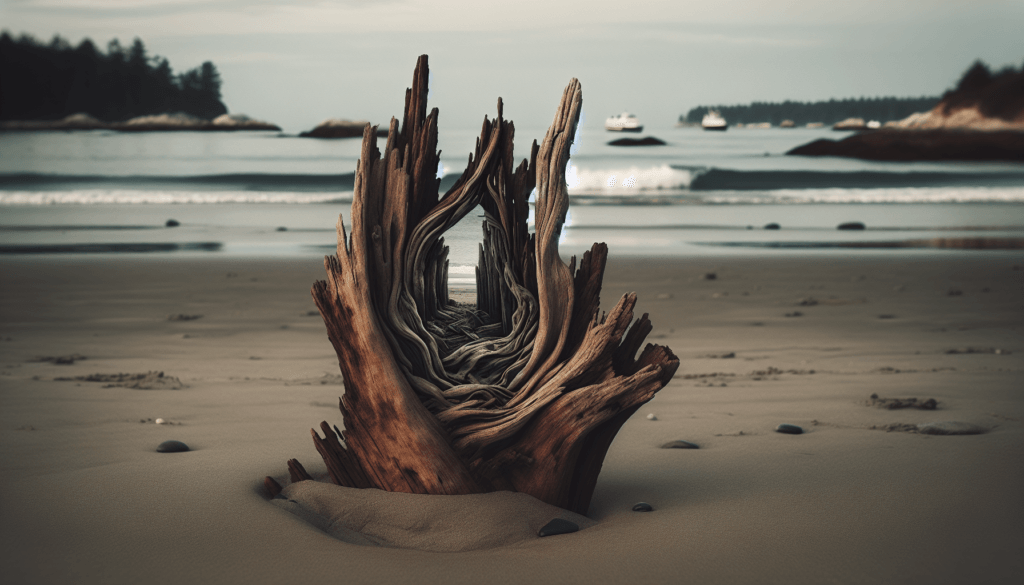Have you ever come across a beautiful piece of driftwood while walking along the beach, and wondered what it means? Driftwood, with its smooth texture and weathered appearance, has long captured the curiosity of beachgoers worldwide. In this article, we will explore the fascinating world of driftwood and uncover the meaning behind its presence on our shores. So, grab your beach hat and join us as we embark on a journey to unravel the mysteries of driftwood!
What is Driftwood?
Driftwood refers to pieces of wood that have been washed up on the shoreline of bodies of water, such as beaches, rivers, and oceans. It is a natural phenomenon that occurs when trees or branches fall into water bodies and are carried away by currents, eventually being deposited on the shore. Driftwood can vary in size, shape, and appearance, and it plays a significant ecological and aesthetic role in coastal ecosystems.
Definition of Driftwood
Driftwood can be defined as any wooden material that has been transported by water and has subsequently been washed ashore. It is typically characterized by its weathered appearance and unique textures, which are the result of prolonged exposure to water and other environmental elements. Driftwood can come from a variety of tree species and can be found in different parts of the world.
Formation of Driftwood
The formation of driftwood begins when trees or branches fall into water bodies, such as rivers or oceans, either due to natural causes like storms or human activities such as logging. Once in the water, the wood is carried away by currents and tides, gradually being transported towards the shoreline. Over time, the continuous movement of water causes the wood to become weathered, eroded, and bleached by the sun, resulting in the characteristic appearance of driftwood.
Types of Driftwood
There are various types of driftwood that can be found in different environments, each with its own unique characteristics.
Beached Driftwood
Beached driftwood refers to pieces of wood that have been deposited on coastal beaches due to ocean currents. This type of driftwood is often found in areas where there is a significant influx of water, such as during storms or high tides. Beached driftwood can vary in size and shape, and it is often characterized by its smooth, weathered appearance, as it has been exposed to the elements for an extended period.
River-Driven Driftwood
River-driven driftwood, as the name suggests, is wood that has been carried by rivers and deposited along their banks or at their mouths. This type of driftwood can be found in freshwater environments and is usually smaller in size compared to beached driftwood. River-driven driftwood can have a more worn appearance due to the faster-flowing water and the rubbing against rocks and other debris during its transport.
Ocean-Driven Driftwood
Ocean-driven driftwood is wood that has traveled long distances in the open ocean before being washed ashore. This type of driftwood is typically found on remote beaches or islands and can be much larger in size compared to other types. Ocean-driven driftwood often has a more unique and impressive appearance, as it can be shaped and worn by the constant exposure to waves and currents.

Characteristics of Driftwood
Driftwood possesses certain characteristics that make it distinct from regular wood.
Appearance
One of the defining features of driftwood is its distinct appearance. It is characterized by its bleached and weathered look, caused by extended exposure to the sun, water, and other elements. Driftwood can range in color from pale whites and grays to deeper browns and blacks, depending on its exposure and the type of wood it originates from. The combination of the wood’s natural grain patterns and the effects of erosion creates a beautiful and unique visual appeal.
Texture
The texture of driftwood is another notable characteristic. After being subjected to the constant movement of water, the wood becomes smooth and polished. The action of waves and currents gradually wears away the rough bark and outer layers, resulting in a surface that feels pleasing to touch. The texture of driftwood can vary depending on the type of wood, the duration of exposure, and the environment in which it was found.
Shape and Size
Driftwood comes in a wide array of shapes and sizes, with no two pieces being exactly the same. The shape of driftwood is often influenced by its journey in water, as it can be sculpted and carved by the forces of nature. Some pieces may be smooth and rounded, while others may be twisted, contorted, or feature intricate patterns. The size of driftwood can range from small, handheld pieces to massive logs that require multiple individuals to move.
Significance of Driftwood
Driftwood holds both ecological and aesthetic value, making it an important element in coastal ecosystems and a popular material for artistic and decorative purposes.
Ecological Importance
In coastal ecosystems, driftwood plays a crucial role in providing habitats for various organisms. The wood acts as a refuge and substrate for numerous marine and terrestrial species. It can provide shelter for small marine organisms such as crabs, worms, and mollusks, as well as nesting sites for birds and reptiles. Driftwood also helps create microhabitats that promote biodiversity and contribute to the overall health of coastal ecosystems.
Aesthetic and Decorative Use
The unique appearance and texture of driftwood make it highly sought after for aesthetic and decorative purposes. Many individuals and designers incorporate driftwood into their interior and exterior designs to create a natural and rustic ambiance. It can be used in the construction of furniture, sculptures, wall art, and other decorative pieces. Driftwood has the ability to add a touch of natural beauty and serenity to any space, enhancing its overall visual appeal.
Symbolism
Beyond its practical and aesthetic values, driftwood holds symbolic significance in various cultures and traditions. It is often associated with resilience, as it represents the ability to withstand the forces of nature and endure challenging circumstances. Driftwood is also seen as a symbol of unity, as it brings together elements of land and water, symbolizing the interconnectedness of different environments and ecosystems.

Uses of Driftwood
Driftwood can serve a variety of functional and artistic purposes, making it a versatile material.
Functional Uses
Due to its durability and natural resistance to decay, driftwood can be used for various functional purposes. It can be utilized in the construction of outdoor furniture, fences, pathways, and even structural elements such as pergolas and bridges. The weathered and unique appearance of driftwood adds a distinct charm to these functional structures, making them truly one-of-a-kind.
Artistic and Craft Uses
Driftwood is highly valued by artists, crafters, and DIY enthusiasts for its versatility and aesthetic qualities. It can be carved, shaped, and painted to create intricate sculptures, wall hangings, and other artistic pieces. Crafters often use smaller pieces of driftwood to make jewelry, wind chimes, and other decorative items. The artistic uses of driftwood allow for creative expression and the celebration of nature’s beauty.
Driftwood in Coastal Ecosystems
Driftwood plays a vital role in coastal ecosystems, providing important ecological benefits and contributing to the overall health of these environments.
Driftwood as Habitats
One of the most significant ecological functions of driftwood is its role as a habitat for various organisms. The cracks and crevices present in driftwood provide refuge for small marine creatures, serving as hiding places and protective shelters. Many species, including insects, crustaceans, and small fishes, rely on the wood as a source of food and refuge. Driftwood also acts as a substrate for the growth of algae, barnacles, and other marine organisms, enhancing the biodiversity of coastal ecosystems.
Role in Nutrient Cycling
Driftwood plays a crucial role in nutrient cycling within coastal ecosystems. As the wood decomposes, it releases organic matter and nutrients into the surrounding environment, enriching the sediment and water with essential elements. These nutrients support the growth of primary producers, such as algae and seagrasses, which form the basis of the coastal food web. In this way, driftwood contributes to the overall productivity and ecological functioning of coastal ecosystems.
Preserving Driftwood
To ensure the longevity and usability of driftwood, it is important to take certain measures to preserve and maintain its quality.
Cleaning and Disinfection
Before using driftwood for any purpose, it is recommended to clean and disinfect it to remove any potential contaminants or pests. This can be done by thoroughly washing the wood with water and a mild detergent, followed by rinsing and drying it properly. Disinfection can be achieved by soaking the driftwood in a solution of water and bleach or using other suitable disinfectants.
Protection from Decay
Driftwood is naturally resistant to decay due to its exposure to water and other elements. However, to further protect it from deterioration, it is advisable to apply a protective sealant or treatment. This can help prevent water absorption, fungal growth, and insect infestation, thereby prolonging the lifespan of the driftwood. Regular inspections and maintenance should also be conducted to identify and address any signs of decay or damage.
Driftwood in Art and Design
Due to its unique characteristics and aesthetic appeal, driftwood has become a popular material in the world of art and design.
Driftwood Sculpture
Driftwood sculptures are intricate artworks created by manipulating and arranging pieces of driftwood into various shapes and forms. Artists often draw inspiration from the natural shapes and textures of the wood, using them to create visually stunning and thought-provoking sculptures. Driftwood sculptures can range from abstract pieces to realistic depictions of animals, people, or objects. The combination of the organic nature of the wood and the artist’s creativity results in captivating and awe-inspiring artworks.
Driftwood Furniture
Driftwood furniture combines functionality with artistic design, resulting in unique and eye-catching pieces. Tables, chairs, benches, and other furniture items made from driftwood can serve as focal points in interior or outdoor spaces. The natural curves, shapes, and textures of the wood provide a rustic and natural appeal, creating a harmonious blend of art and functionality.
Driftwood as Decorative Pieces
Driftwood is often used as decorative pieces in interior design and landscaping projects. It can be incorporated into wall hangings, mirrors, lamps, and other decorative accessories, adding a touch of nature and creating a calming atmosphere. In outdoor spaces, driftwood can be used to create unique garden features, such as arbors, sculptures, or fences, adding character and charm to the landscape.
Driftwood in Folklore and Culture
Throughout history, driftwood has held symbolic and cultural significance in various folklore and traditions.
Mythological References
In many mythologies and folktales, driftwood is associated with mystical and supernatural powers. It is often seen as a sacred material or a bridge between the natural and spiritual realms. In some cultures, driftwood is believed to have the ability to bring good luck, protect against evil spirits, or even possess healing properties. These myths and beliefs highlight the deep connection between human cultures and the natural world.
Cultural Practices and Beliefs
Driftwood has been incorporated into various cultural practices and rituals around the world. In some coastal communities, the gathering and utilization of driftwood holds special cultural significance. It may be used in the construction of traditional houses, canoes, or in the creation of ceremonial objects. Driftwood is also utilized in artistic performances, storytelling, and other forms of cultural expression, reinforcing the importance of this natural resource in local traditions.
Conclusion
Driftwood is more than just pieces of wood washed up on the shore. It is a fascinating natural phenomenon that serves important ecological functions, provides aesthetic value, and holds symbolic significance. From its formation through the forces of water to its diverse uses in art, design, and cultural practices, driftwood continues to captivate and inspire. Its weathered beauty reminds us of the power of nature and the interconnectedness of our natural world. So the next time you come across a piece of driftwood, take a moment to appreciate its unique qualities and the stories it may carry.



